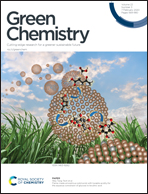Salt template-assisted in situ construction of Ru nanoclusters and porous carbon: excellent catalysts toward hydrogen evolution, ammonia-borane hydrolysis, and 4-nitrophenol reduction†
Abstract
Sustainable yet effective manufacture of supported metal nanoclusters (NCs) with high performance for catalytic applications is worthwhile but remains a big challenge. Here, we report a salt template-assisted approach through direct calcination of a mixture of ruthenium oleate precursor and sodium sulfate for one-step synthesis of Ru NCs solidly loaded on the simultaneously formed porous carbon (Ru/PC). In this case, both the salt template of sodium sulfate and one-step approach play key roles in forming surface-clean Ru NCs with good dispersion to supply abundant accessible active sites and constructing a three-dimensional architecture to boost the mass and/or electron transport during applications. Taking advantage of these features, Ru/PC as a catalyst shows excellent activities for electrocatalytic hydrogen evolution with an overpotential of 21 mV at 10 mA cm−2 in 1.0 M KOH and ammonia-borane hydrolysis with a high turnover frequency of 744 min−1 and a high activity for 4-nitrophenol reduction with a reaction rate of 1.29 min−1 at room temperature. The catalyst also shows high stability and reusability for the investigated reactions. This study presents a green yet sustainable method to produce supported metal NCs for versatile catalytic applications.



 Please wait while we load your content...
Please wait while we load your content...